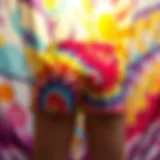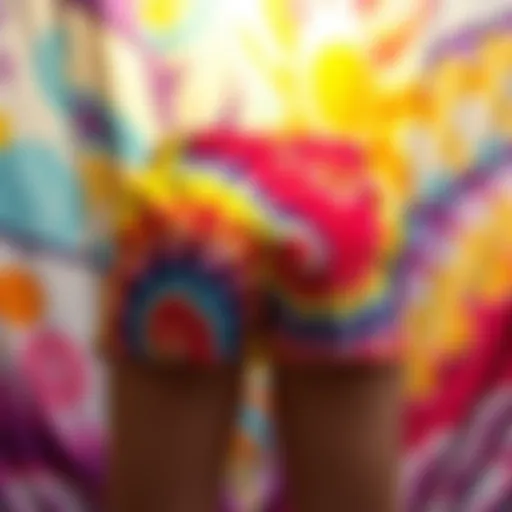Exploring the Impact of Color on T-Shirts
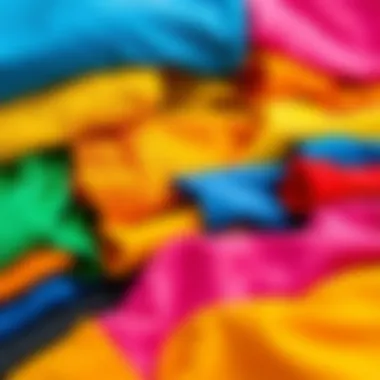
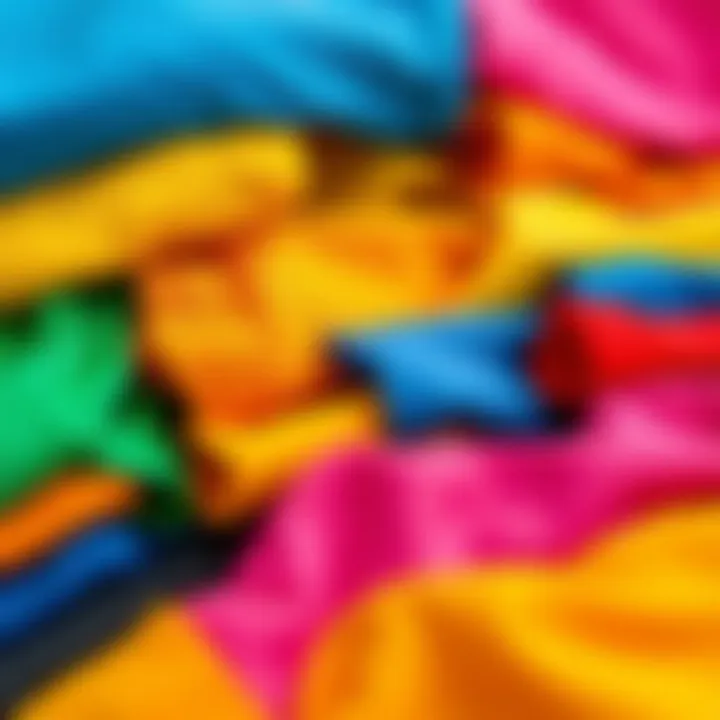
Intro
T-shirts often serve as a canvas to express individuality and to make statements without uttering a word. While a simple piece of clothing at first glance, the color of a t-shirt can springboard a dialogue about fashion, culture, and even psychology. What one wears can delineate their vibe, mood, and personality. From vibrant hues that ignite energy to muted tones that whisper subtleness, colors hold an immense significance in the world of t-shirts.
This article embarks on a detailed exploration of the multifaceted relationship between t-shirts and color, mixing vibrant anecdotes with theoretical musings. Each color choice not only unfolds a chapter of personal style but reflects broader societal trends and cultural narratives. As we peel back the layers, we aim to uncover how trends evolve, the intrinsic meaning behind color choices, and sustainability's quietly growing influence in the fashion industry.
Let’s dive into the modern world of fashion trends that shape our beloved t-shirts, followed by practical style tips that can make a t-shirt not just an item of clothing but a statement piece.
The Significance of T-Shirts in Modern Fashion
T-shirts have woven themselves into the very fabric of modern fashion, transcending their origins as mere undershirts to become a canvas for personal expression and cultural commentary. The significance of t-shirts in contemporary style is multifaceted. On one hand, they serve as a democratic form of clothing, accessible to all strata of society. On the other, they reflect broader social, political, and artistic movements, acting as a mirror to the values and beliefs of different generations.
When we look at the role of t-shirts, we recognize several critical elements. First and foremost, they are versatile. A t-shirt can be dressed up with a blazer for a trendy evening out or paired with joggers for a lazy Sunday afternoon. This adaptability makes them suitable for various occasions, from casual hangouts to semi-formal gatherings. Moreover, t-shirts act as a democratizing element in fashion, offering a platform where everyone can express their identity without excessive restraint imposed by trends or social norms.
In addition to versatility, t-shirts can also carry powerful messages. Graphic tees often illustrate social justice issues, political stances, or pop culture reflections, allowing wearers to articulate their beliefs through clothing. This not only creates a dialogue between the wearer and the observer but also fosters a sense of community among those who share similar views.
Historical Context
Understanding the impact of t-shirts in fashion requires a glimpse into their history. The t-shirt originated as a simple garment to be worn under uniforms or work shirts in the late 19th and early 20th centuries. However, their evolution began during World War II when servicemen started wearing them as casual wear, embracing their comfort. Post-war America saw a surge in t-shirt popularity, influenced heavily by movies, music, and eventually, the counterculture movements.
In the 1960s and 1970s, the t-shirt transformed into more than a piece of clothing; it became a medium of expression. Artists and designers began to use fabric as a canvas, printing various images, slogans, and graphics. This era set the groundwork for what we see today—a global industry thriving on creativity and personalized fashion.
Cultural Icons and Movements
T-shirts have always been at the forefront of cultural movements, playing a critical role in shaping identity, rebellion, and allegiance. Iconic figures like James Dean and Marilyn Monroe immortalized the classic white t-shirt as a symbol of youthful rebellion in the 1950s. Fast forward a few decades, and the punk rock scene of the late 70s and 80s employed graphic tees to make bold statements against the status quo, showcasing band logos and political messages.
Moreover, brands such as Chanel and Supreme have turned the t-shirt into a luxury item, creating limited-edition pieces that often result in culture shocks and mass anticipation. These cultural exchanges illustrate just how pivotal t-shirts are in reflecting and influencing ideologies and aesthetics. They are not merely fabric stitched together but rather a conduit for storytelling and a reflection of personal and collective identities.
"T-shirts are for more than just wearing; they are an active display of cultural narratives that encapsulate the spirit of the times."
Understanding Color Theory
Color theory serves as the foundation for much of the design and aesthetic decisions that surround t-shirts, influencing everything from brand identity to consumer emotions. In this context, understanding how colors interact not only aids designers and brands in creating appealing products but also enhances the overall experience of wearing and showcasing these garments. Moreover, color theory teaches how colors can evoke feelings or symbolize ideas. Grasping these nuances is essential for stylists, designers, and marketers aiming to resonate with their audience.
Primary, Secondary, and Tertiary Colors
To understand color theory more deeply, we must look at the basic color categories: primary, secondary, and tertiary colors.
- Primary Colors: These are the building blocks of color. Red, blue, and yellow cannot be created by mixing other colors. Artists and marketing professionals alike regard them as fundamental in crafting compelling designs. For instance, a vibrant red t-shirt can convey passion and energy, making it an eye-catching choice for consumers.
- Secondary Colors: When two primary colors are mixed, they create secondary colors. Green, orange, and purple fall into this category. A designer might choose a deep orange t-shirt to evoke warmth and creativity, combining the energy of red and the calm of yellow.
- Tertiary Colors: These colors result from mixing a primary color with a secondary color. Examples include red-orange and yellow-green. These hues add complexity and richness to t-shirt designs. For instance, a muted yellow-green could appeal to an audience looking for something earthy and organic.
Recognizing these color intersections can help artists and marketers cater to specific demographics or cultural trends effectively.
The Color Wheel Explained
The color wheel is a visual representation of color relationships and is a vital tool for anyone working with color.^[Source: https://en.wikipedia.org/wiki/Color_wheel] It illustrates how colors relate to one another, forming a basis for color matching in t-shirt design.
- Complementary Colors: Located opposite each other on the wheel, they create contrast. A t-shirt that uses blue and orange as its main colors achieves a balance that captivates the eye.
- Analogous Colors: These colors sit next to one another on the color wheel. Using analogous colors, like blue, blue-green, and green, results in designs that are harmonious and pleasing to the eye.
- Triadic Colors: This scheme utilizes three colors evenly spaced on the wheel, creating vibrant designs. A combination of red, yellow, and blue could make for a playful yet striking creation.
Understanding the color wheel is not just academic; it affects how a t-shirt can be perceived and the message it communicates. A thoughtfully chosen color palette can elevate a simple piece of clothing into a statement that reflects both personality and the zeitgeist.
"Color is the keyboard, the eyes are the harmonies, the soul is the piano with many strings." -Wassily Kandinsky
In essence, a solid grasp of color theory empowers designers to create t-shirts that do not merely clothe but also express, evoke, and resonate. As this exploration continues, it becomes clear that color is not just a visual preference; it's a language of its own within the realm of fashion.
Psychology of Color in Fashion
Color is not just an aesthetic choice in fashion; it is a powerful psychological tool that can influence our emotions, perceptions, and behaviors. Understanding the psychology of color is crucial for stylists, designers, and marketers, especially when it comes to the ubiquitous t-shirt. A simple garment can carry profound implications based on the hues chosen, resonating deeply with individuals' identities and cultural backgrounds. Color acts as a silent communicator, shaping how we perceive and interact with clothing and, by extension, with each other.
Emotional Associations
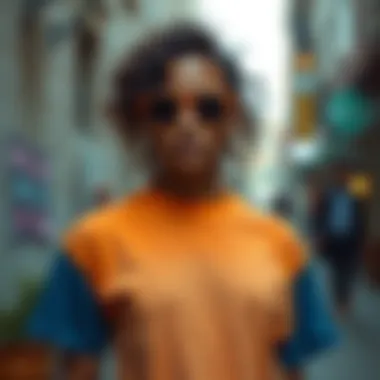
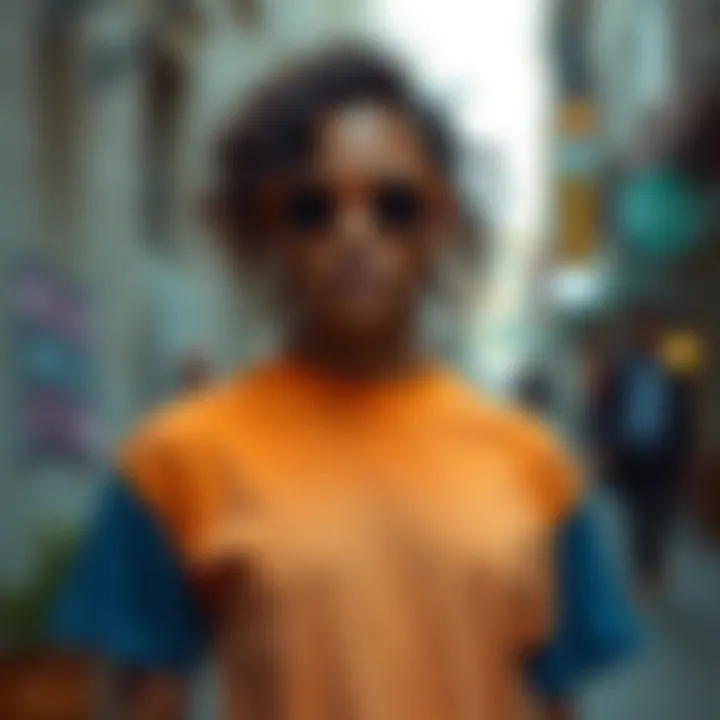
Different colors evoke specific feelings and associations that vary across cultures and personal experiences. A bright red t-shirt might convey passion and energy, while a blue one often brings to mind calmness and trust.
Here is a brief overview of some common emotional associations:
- Red: Energetic, passionate, and sometimes aggressive.
- Blue: Trustworthy, peaceful, and professional.
- Yellow: Cheerful, optimistic, and attention-grabbing.
- Green: Refreshing, calming, and associated with nature.
- Black: Elegant, sophisticated, but it can also symbolize mourning or rebellion.
- White: Purity, simplicity, and freshness.
Consider how these associations manifest when people choose to don a t-shirt in a particular color. A person might select a flannel red t-shirt for a social gathering, hoping to project warmth and enthusiasm. Simultaneously, another may opt for a subdued blue for a business casual meeting, favoring the trustworthiness it evokes.
Popular T-Shirt Colors Through the Decades
When it comes to fashion, especially in the realm of t-shirts, colors play a pivotal role in signaling trends, societal moods, and cultural shifts. Colors can evoke emotions, create associations, and serve as visual statements that capture the essence of a particular era. This section delves into how t-shirt colors have evolved through the decades, from bold statements of the Nineties to the soft hues of the Two-thousands. Understanding these changes allows for a deeper appreciation of t-shirts, not just as clothing, but as reflections of broader cultural phenomena.
The Nineties and Bold Hues
The Nineties wore their vibrancy like a badge of honor. Bright and audacious colors dominated the decade, making t-shirts extensions of personal expression and rebellion. Consider the iconic graphic tees sporting primary colors and bold typographic designs. Think of how figures like Kurt Cobain of Nirvana popularized this trend by donning oversized tees adorned with loud prints, signifying an embrace of individuality amid a backdrop of grunge.
- Neon colors. There was an irresistible allure to electric greens, hot pinks, and flaming oranges that seemed to leap off the fabric. Many youth culture movements adopted these colors, making them woven into the fabric of 90s pop culture. T-shirts not only became personal garments but also symbols of affiliation to various subcultures.
- Tie-dye resurgence. As the Sixties’ love for tie-dye made a comeback, Nineties youth put their twist on it by creating custom patterns. This wasn’t just a fashion statement; it also embodied a do-it-yourself ethos that resonated with many.
In summary, the bold hues of t-shirts in the Nineties were not just about color; they conveyed a sense of attitude, freedom, and self-expression. Wearing vivid colors became a way for individuals to stand out and assert their identity in a rapidly changing world.
Pastel Trends in the Two-thousands
Shifting gears into the Two-thousands, we witnessed a softening of colors in t-shirt designs that paralleled a greater focus on minimalism in fashion. Pastel shades became the go-to choice for many, signaling an era that valued comfort and simplicity. Soft pinks, mint greens, and baby blues characterized this period, offering a refreshing contrast to the brash statements of the previous decade.
- Emphasis on comfort and everyday wear. There was a notable shift toward casual wear, with many preferring lighter fabrics in these soothing colors. T-shirts in softer shades caused one to feel relaxed, which reflected the general desire for comfort and approachability.
- Cultural influences. This pastel trend was propelled by various social mediums, whereby iconic figures in music and television adopted softer tones. Artists like Taylor Swift and shows like Friends embraced these colors, further embedding them into the mainstream consciousness.
As we look back, the pastel colors of the Two-thousands signified a shift in societal values, aligning with the desire for more introspective and less brash fashion choices. The muted palettes were not just about aesthetics—they were about creating a sense of calm and ease amidst a world that was becoming increasingly chaotic.
In these evolving shades through the decades, t-shirts serve as a canvas for personal and cultural identity, reflecting how color can hold deeper meanings in the ever-changing landscape of fashion.
T-Shirt Design and Color Choices
The design of a t-shirt goes beyond just the cut, fabric, and graphic; it weaves a narrative that connects color choices with personal expression and cultural influence. In today’s world, where trends shift faster than a ticking clock, the role of color in t-shirt design cannot be understated. Selecting the right hues can amplify message, enhance brand identity, and create emotional resonance with the audience. The benefits of thoughtful color selection include not just aesthetic appeal but also increased marketability. These factors play a vital role in shaping consumer preferences, fostering a deeper connection between the garment and the wearer.
Color Combinations and Harmony
When it comes to t-shirt design, color combinations can either make or break the visual impact. An understanding of basic color theory aids designers in crafting harmonious palettes that elevate the overall design. A failure to grasp these principles often leads to chaos on fabric, resulting in a design that feels disjointed.
For instance, a t-shirt designed with a vibrant orange and a soft blue can evoke a sense of cheerfulness yet remain grounded. This blend not only attracts attention but also invites comfort - a balance of energy and serenity. Such thoughtful combinations can be observed in brands like H&M and Zara, which flawlessly integrate color palettes appealing to a broad audience.
To achieve harmony, designers can utilize the following strategies:
- Analogous Colors: Using colors that sit next to each other on the color wheel can create a serene and comfortable design. For example, a palette of greens and blues can convey a fresh, natural vibe.
- Triadic Colors: Selecting three colors that are evenly spaced around the color wheel, such as red, yellow, and blue, can provide a vibrant and dynamic look. This is ideal for designs aimed at a youthful audience.
- Monochromatic Schemes: A design featuring varying shades of a single color can create a sophisticated, understated look that speaks to subtlety and elegance.
In summary, an effective color combination not only ensures a pleasing aesthetic but also communicates a brand’s essence. Striking that balance is key in t-shirt design, as it influences not just individual style but collective trends.
Contrasting and Complementary Colors
Contrasting and complementary colors play a significant role in t-shirt design, drawing attention to key elements while also providing a striking visual appeal. Understanding this dynamic can profoundly impact how a t-shirt is perceived.
Contrasting colors, those that sit opposite each other on the color wheel, have a unique ability to create excitement and drama in a design. For instance, pairing a deep navy with a bright mustard can bring an energetic dynamism to an otherwise simple t-shirt. This strategy works particularly well for brands aiming to stand out in crowded marketplaces, ensuring that their designs attract the eye in a flash.
On the flip side, complementary colors, which soften the presence of one another, are equally important in achieving balance. A design with a deep green font on a muted peach background allows the text to pop without overwhelming the viewer. This subtlety is crucial for brands that wish to convey sophistication and elegance while maintaining visibility.
Guidelines for implementing contrasting and complementary colors in t-shirt designs could include:
- Experimentation: Playing with different contrasting colors in mock-ups before finalizing designs can reveal unexpected combinations that resonate well.
- Audience Consideration: Recognizing the target market’s preferences can steer the choice of contrasting or complementary colors. For example, youthful brands may thrive on vibrant clashes, while high-fashion labels may prefer muted contrasts.
- Cultural Context: Some colors hold different meanings in various cultures; being aware of these can steer color choices effectively.
Cultural and Regional Color Preferences
The importance of cultural and regional color preferences cannot be overstated in the realm of t-shirts. Colors hold distinct meanings in various cultures and can evoke powerful emotions or societal messages. Understanding these nuances helps designers and marketers create apparel that resonates deeply with target audiences. Considering color preferences adds not just aesthetic value but also cultural significance to the choice of t-shirt designs, influencing everything from sales to brand loyalty.
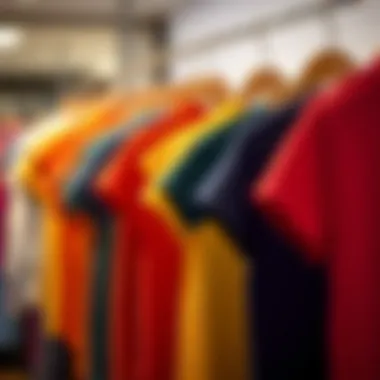
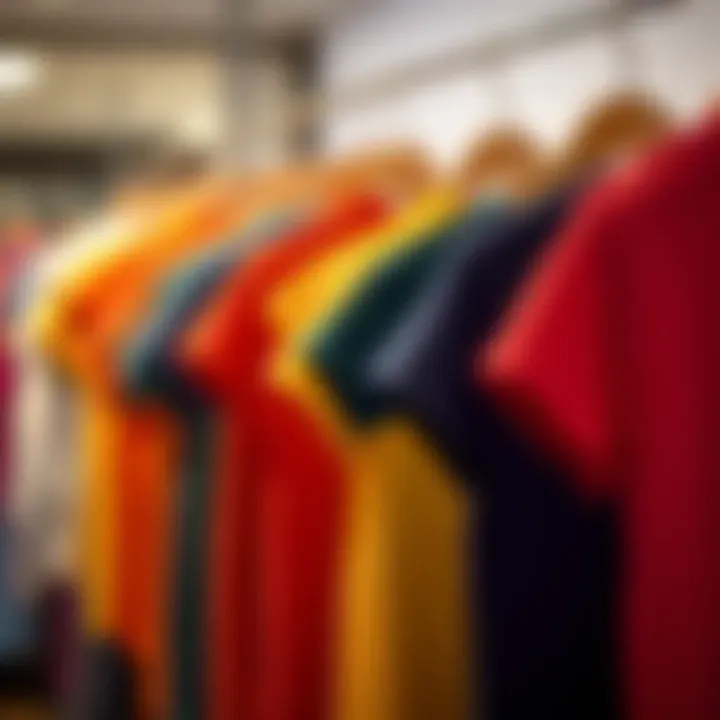
Color Symbolism Across Cultures
When it comes to symbolism, colors wear many hats around the globe. In Western cultures, white often embodies purity and new beginnings; however, in some Eastern traditions, it may be associated with mourning and funerals. Red, a color of celebration in China, may also signify danger in other contexts. The complexity of color meanings can create a vibrant tapestry, where shades overlap and create rich interpretive possibilities.
- Red: Love and passion in many cultures; threat in others.
- Blue: Calmness in the West; associated with spirituality in Eastern traditions.
- Green: Nature and renewal universally, but can symbolize envy in some cultures.
- Black: Often connected to formality and elegance, as well as death in various societies.
Cultural nuances also shape the emotional connection consumers have with certain colored t-shirts. When a brand taps into these cultural significances, it can create lasting relevance.
Understanding the symbolism of colors across cultures not only enhances design aesthetics but also fosters deeper connections with consumers.
Global T-Shirt Color Trends
As we traverse the globe, t-shirt color trends emerge as reflections of regional styles, preferences, and cultural moments. From the muted pastels of Scandinavian minimalism to the bold vibrancy found in South American streetwear, t-shirt colors vary widely, offering a palette enriched by local identity.
Currently, some color trends seem to resonate across borders:
- Earthy Tones: With rising interest in sustainability, colors like terracotta and olive green are gaining traction, linking consumers to nature and environmental responsibility.
- Neon Shades: A throwback to the ’80s, neon hues like hot pink and electric blue are resurging, often seen in youth-driven urban fashion.
- Monochrome Palettes: The love for simplicity is evident, with white, black, and gray t-shirts reigning supreme in many wardrobes, reflecting a preference for versatility.
- Tie-Dye and Custom Colors: The do-it-yourself aesthetic is becoming a staple as consumers seek uniqueness and personalization in their clothing.
With globalization, the interplay of local and global influences has made it critical for t-shirt brands to stay attuned to these shifting color trends. Those who navigate these waters skillfully not only attract attention but also create apparel that tells a story about culture and identity.
To stay updated on color trends and industry insights, you might find the following resources helpful:
Sustainability and Color in T-Shirt Production
In the realm of fashion, the urgency for sustainable practices has never been more pronounced. T-shirts, being a staple of modern wardrobes, mirror the complexities involved in sustainable clothing production. Their color plays a crucial role not just aesthetically, but environmentally too. The way color is applied in t-shirt production can greatly affect both the ecosystem and communities involved in garment manufacturing.
Key Considerations for Sustainability and Color
Understanding the intersection of sustainability and color in t-shirt production involves many layers. Not only is there a need for eco-friendly dyes that minimize environmental impact, but there are practices in the manufacturing process that can either enhance or detract from these efforts. As consumers increasingly favor brands that advocate for sustainable practices, manufacturers must adapt to meet such expectations. This means carefully selecting dyes, utilizing innovative resources, and adopting ethical production methodologies.
"Choosing the right color not just defines the look of the t-shirt but also speaks volumes about the brand's commitment to sustainability."
Such alignment focuses on a triple bottom line—people, planet, and profit. When designers consider sustainability, they must think critically about the materials they use, the environmental toll of the coloring process, and the intended lifecycle of what they create. Color isn't just a superficial aspect; it can be a signal of the brand's values and ethical practices.
Eco-Friendly Dyes and Practices
Eco-friendly dyes represent a major leap toward sustainability in t-shirt production. Unlike traditional dyes, which can be laden with toxic chemicals, eco-friendly options, such as natural dyes from plants or organic synthetic dyes, present a lower environmental burden. These dyes not only reduce the risk of water pollution but also benefit the workers who handle them.
- Natural Dyes: These are derived from plants, insects, or minerals. They come with a touch of unpredictability, often resulting in unique shades. Brands like Beardwood&Co have embraced this approach, ensuring a lesser carbon footprint.
- Low-Impact Dyes: These synthetic dyes require less water and energy to produce, making them a favorable alternative. DyeCoo Textile Systems has pioneered such processes, significantly reducing water usage in their operations.
- Non-Toxic Chemicals: With advancements in dye technologies, many brands are turning to non-toxic chemicals that don’t pose a threat to the environment.
By transitioning to these eco-friendly alternatives, brands can demonstrate their dedication not only to the aesthetic appeal of colors but also to environmental stewardship.
The Environmental Impact of Color Treatments
Color treatments can have a profound impact on the sustainability of t-shirt production. The processes involved in dyeing and finishing fabrics often contribute to pollution if not managed properly. Here are a few considerations that highlight this impact:
- Water Usage: Traditional dyeing processes consume vast amounts of water, contributing to scarcity issues, especially in regions already facing shortages.
- Chemical Waste: Many dyes contain harmful chemicals that, if not disposed of correctly, can leach into waterways, damaging ecosystems and harming wildlife.
- Energy Consumption: Some dyeing methods require significant energy input, contributing to greenhouse gas emissions. Sustainable practices aim to minimize this, striving for energy-efficient solutions such as solar-powered dyeing technology.
In an industry where visual appeal is paramount, the focus on sustainability through color treatments allows brands not to sacrifice aesthetics for ethics. Consumers are becoming savvy, demanding full transparency regarding how their clothes are colored and how responsibly they are produced.
By understanding the implications of color in t-shirt production, today's designers, marketers, and consumers hold the power to shape a more sustainable future in fashion.
The Role of Technology in Color Selection
In today's fast-paced fashion industry, the role of technology in color selection cannot be overstated. Innovation has transformed how designers approach color, enabling them to create more vibrant, appealing, and relevant t-shirt collections. Designers now have access to tools that not only facilitate the design process but also ensure that the colors resonate with targeted audiences.
From digital color palettes to automated trends analysis, technology provides a comprehensive approach to color strategy. This integration of digital tools and artificial intelligence into the color selection process drastically streamlines workflow while enhancing creativity, making it a vital topic within this exploration.
Digital Tools for Designers


Digital tools have emerged as game-changers for t-shirt designers. These software solutions empower creatives to visualize colors and patterns without the fuss of traditional methods.
Some particularly notable tools include:
- Adobe Color: This platform lets designers create color schemes based on various harmonies. Designers can explore different palettes and see how they interact visually.
- CorelDRAW: Not only does this software offer powerful vector illustration capabilities, but it also allows users to experiment with colors in real time, ensuring designs remain fresh and pertinent.
- Canva: Popular among non-professional designers, Canva offers various templates that include color suggestions, making the ideation process accessible and collaborative.
These tools bridge the gap between concept and execution. Designers can test, adjust, and perfect their color selections before they hit production, potentially saving both time and materials.
Artificial Intelligence and Color Trends
Artificial Intelligence (AI) is creating ripples in the fashion landscape, particularly regarding color trends. With algorithms capable of analyzing vast datasets—from social media imagery to fashion shows—AI identifies emerging trends at an incredible pace. This ensures that designers can adapt their color strategies proactively and effectively.
For instance, AI-driven platforms like Stylitics analyze what consumers favor in real time, offering insights into which colors are gaining traction among specific demographics. This data allows brands to align their color offerings with user preferences, enhancing customer satisfaction and market relevance.
Moreover, the predictive capabilities of AI help in forecasting seasonal trends. By analyzing previous seasons alongside current societal pulses, brands can foresee shifts in color demand and prepare accordingly, reducing the risk of being out of sync with consumer expectations.
In the fashion industry, where timing is crucial, the ability to predict color trends through AI can be the difference between a successful launch and an underwhelming one.
In summary, the role of technology in color selection, through digital tools and AI, significantly enriches the creative process. The integration of these technologies empowers designers to make informed, timely decisions, ultimately enhancing the appeal of t-shirt designs in an ever-evolving market.
Consumer Preferences and Trends in T-Shirt Colors
Understanding the ebb and flow of consumer preferences in t-shirt colors is like navigating a winding river; it’s constantly changing, influenced by cultural tides, social movements, and even whispers of nostalgia. The colors we choose to wear are not just a matter of personal taste; they're reflections of emotions, identities, and societal values. T-shirts, often worn as canvases for self-expression, offer insights into larger trends and consumer behaviors.
When discussing color preferences, it's vital to recognize that color is an emotional conduit. Different hues evoke distinct feelings. For instance, vibrant shades of yellow and orange tend to uplift spirits, while somber tones like grey may signal a more subdued mood. This emotional resonance can significantly impact purchasing decisions. In recent years, consumers have shown a preference for earth tones, which align with the growing trend of sustainability and a return to nature. The color palette people choose can reveal their values, beliefs, and lifestyle choices.
Surveying the Market: Color Preferences
Market studies provide a lens through which we can understand how colors resonate with contemporary audiences. An in-depth survey analyzing color preferences among various demographics reveals several insights:
- Neutral Colors: Black, white, and grey consistently rank high. They serve as staples, versatile enough for various combinations and occasions.
- Earthy Tones: Shades like olive, terracotta, and deep brown have gained popularity, especially among eco-conscious consumers.
- Bold Hues: Bright colors, such as electric blue or hot pink, continue to attract younger crowds, often drawn to the need for individuality.
As the world evolves, so do preferences. For example, the rise of minimalism has paved the way for a resurgence in monochromatic designs, while the retro wave has ushered in a revival of pastel shades reminiscent of the eighties. The ability to discern these trends can be a game-changer for marketers and designers looking to cater to the ever-changing tastes of consumers.
Influencers and Social Media's Role
In today’s digital age, social media isn't just a platform for sharing photos; it's a powerful influencer of consumer behavior. The visual nature of platforms like Instagram and TikTok allows trends to spiral out of control, crossing borders at lightning speed. Influencers, with their curated personal brands, shape the way color preferences evolve by:
- Showcasing Styles: They often set the tone for color trends. An influencer sporting a particular hue can lead to hordes of followers seeking out similar shades.
- Community Engagement: Through polls, ask-me-anything sessions, and interactive stories, influencers gauge their audience's preferences directly, shaping future styles and color choices in real time.
- Promoting Ethical Brands: Many influencers advocate for sustainable fashion, influencing their followers to lean toward brands that align with eco-friendly values. This shift can dramatically affect sourcing practices in the apparel industry.
In essence, the interplay between consumer preferences and the influence of social media creates a landscape ripe for exploring color trends. The nimbleness of brands in adapting to these preferences could determine their success in a crowded marketplace.
As fashion becomes increasingly democratic, where the voices of mere consumers are amplified through social platforms, the dialogue around color and identity in t-shirts grows richer and more complex.
For more insights on consumer trends, you might check Market Research Reports by Statista or explore discussions on platforms like Reddit Fashion. Understanding these dynamics is vital for anyone involved in the worlds of styling, design, and marketing.
Ethical Considerations in Color Production
The production of t-shirts goes beyond mere fabric and stitching; it delves into a realm intertwined with ethics, responsibility, and awareness. As consumers become more discerning, the implications of color choices in t-shirt manufacturing take center stage, impacting not just aesthetics but the ethical landscape of the industry. This discussion is critical, centering on two major factors: fair trade practices and transparency in the supply chain.
Fair Trade Practices and Color
Fair trade practices represent a significant movement aimed at creating equitable relationships between producers and consumers. In the world of t-shirts, this means that those who dye, print, and weave these garments are compensated fairly for their labor. Ethical production doesn’t just concern the workers but also the environment; many fair trade initiatives advocate for the use of sustainable dyes and methods that minimize harm to ecosystems.
For instance, using natural dyes from plants or minerals can offer a vibrant palette while reducing the chemical load on our environment. Imagine a t-shirt dyed with indigo from the leaves of the indigo plant, contributing to biodiversity instead of harming it. This practice not only results in unique shades but also supports local farmers and their communities, helping them to thrive economically.
Fair trade practices build bridges—offering artisans both dignity and a sustainable income while celebrating the beauty of diverse colors.
Moreover, consumers increasingly seek to understand how their purchases help shape the lives of the people behind the products. Purchasing a fair trade t-shirt means supporting a cycle of ethical production that values both human labor and environmental health. By wearing a shirt that embraces fair trade principles, individuals are also making a statement about their values.
Transparency in the Supply Chain
In our era of information, transparency in the supply chain is not simply a trend; it is essential. Consumers demand to know where their t-shirts come from and how they were produced. A transparent supply chain allows for a clearer view of a brand’s ethical practices regarding color production. This transparency builds trust. When t-shirt brands disclose the origins of their dyes, the conditions under which workers labor, and the impact on local ecosystems, they empower consumers to make informed choices.
With platforms like Transparency-One and other traceability technologies, brands can track the journey of their fabrics from farm to consumer. This evolution is crucial as suppliers and brands work diligently to embody ethical color practices that resonate with modern consumers. Transparency helps eliminate greenwashing—a term for when companies mislead consumers about their sustainability efforts.
By demanding and embracing transparency, consumers play an active role in advocating for ethically produced colors in fashion. Knowledge is power, and when the public is equipped with information, they can support businesses that align with their values.










